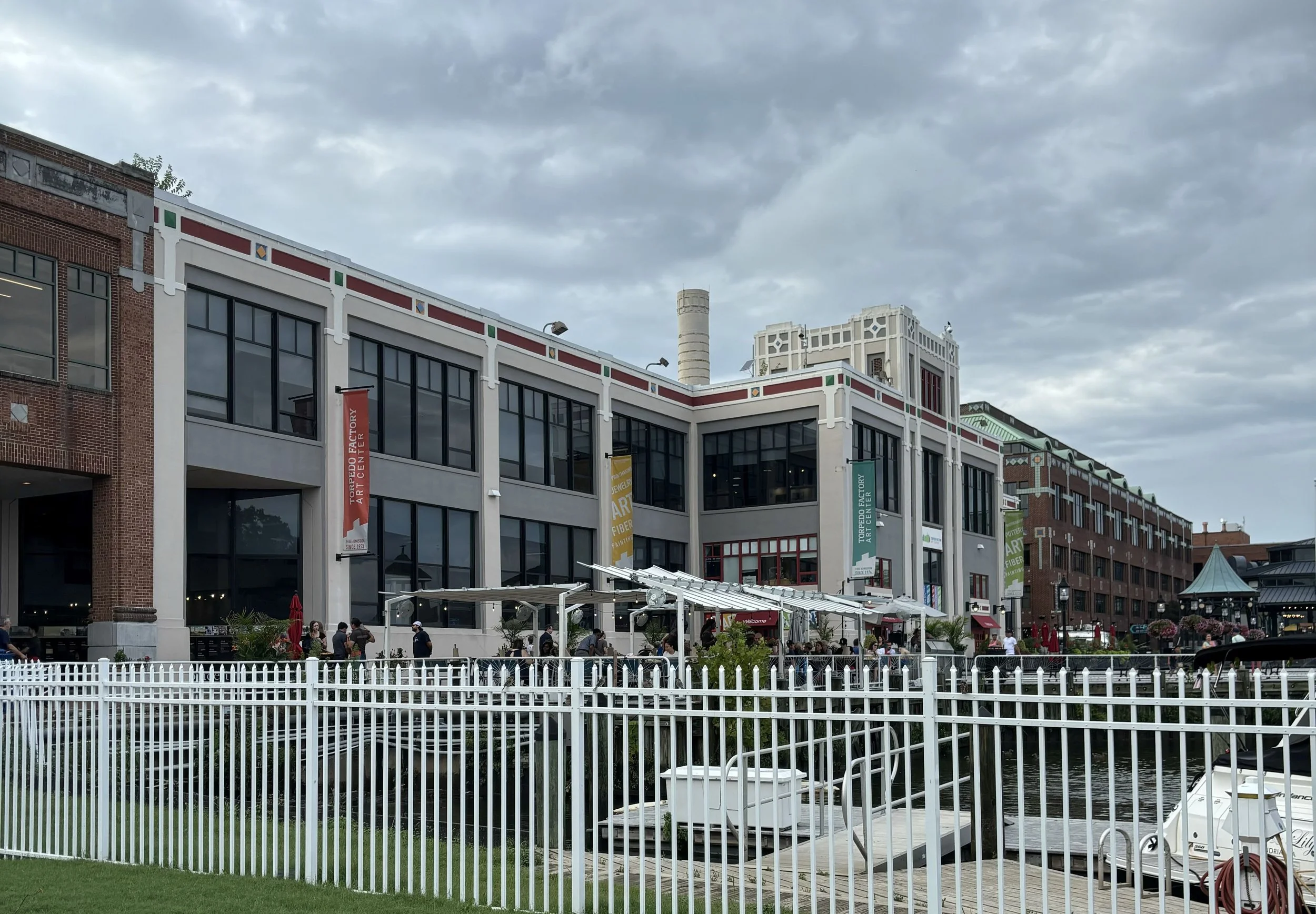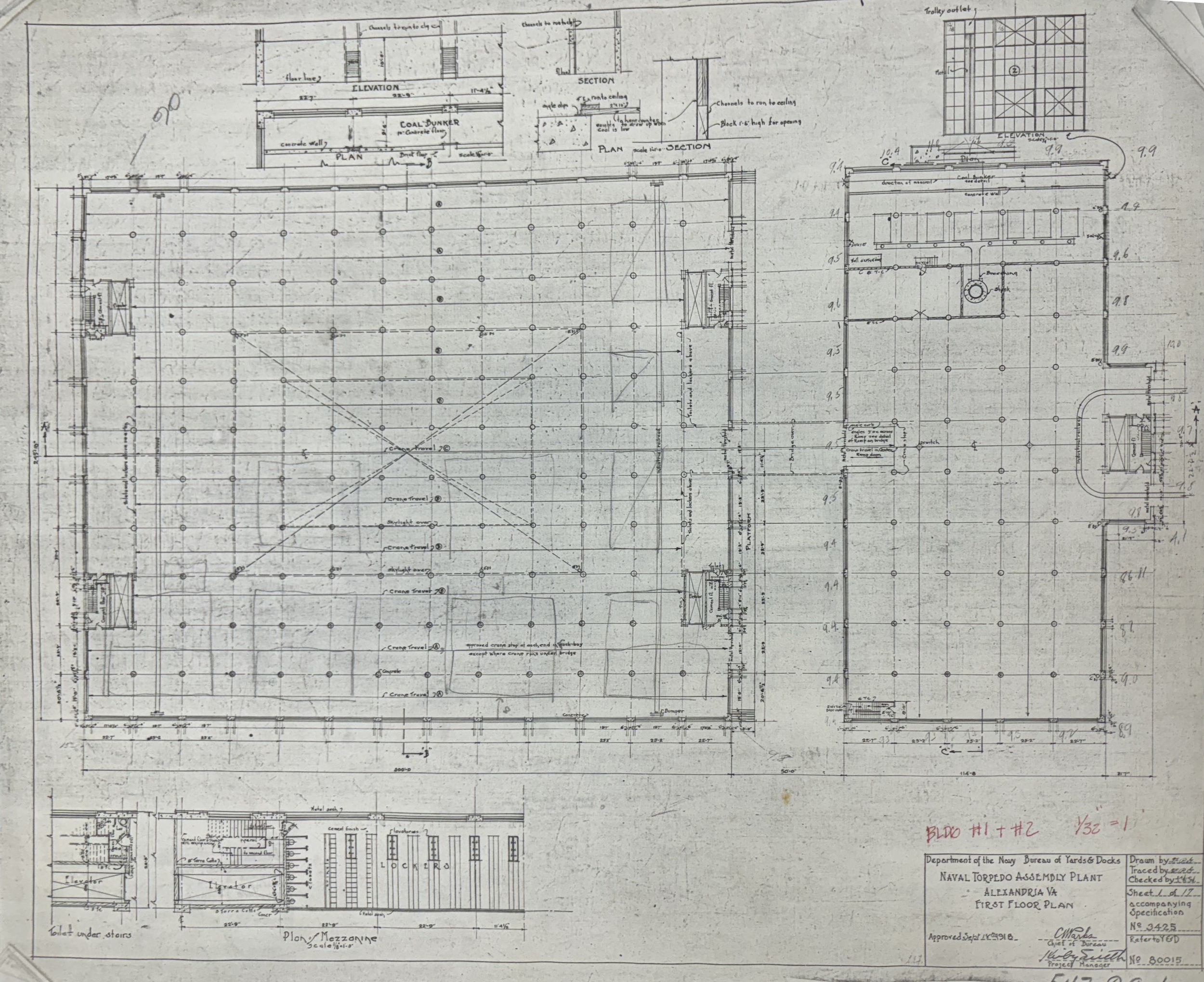
THE TORPEDO FACTORY ART CENTER
THE FACTORY
The Torpedo Factory Art Center, as indicated by its name, was once a munitions plant for the manufacturing of torpedoes. The original complex of ten buildings was called the U.S. Naval Torpedo Station, and construction began the day after Armistice Day, November 12, 1918. Building 2, where the Art Center is now housed, was completed in January 1919.
The Station manufactured Mark III torpedoes for a few years until production stopped in 1923. The facility then served as a munitions storage area for a time. Production ramped up once again at the onset of World War II, the plant producing in total 9,920 torpedoes from 1939 to 1946. After the end of the War, the Station briefly manufactured parts for rocket engines until shutting down permanently in 1946.
In the images to the left, the smaller “storage building” to the right of the larger structure (the “assembly building”) is the current Art Center building.
Similarly, in the larger background image, the smaller structure to the right labeled the “storage house” is the current Art Center building.
Image Credit
First Floor Plan; Second Floor Plan; Third & Fourth Floors and Roof Plans; and Elevations
“Naval Torpedo Assembly Plant,“ September 18,1918
City of Alexandria Archives and Records Center
THE FEDERAL RECORDS CENTER
By 1950, the United States General Service Administration converted the Station into the Federal Records Center. It stored congressional documents, German war films, and Nuremberg War Crimes trial records. The Smithsonian Institution also used it for storage, with the facility at one point storing dinosaur bones.
In 1969, the City of Alexandria purchased from the Federal Government the entire Torpedo Factory complex as well as the waterfront docks and piers for $1,600,000. Full possession of the property would take place in 5 years after the Federal Records Center was completely emptied, with demolition being considered.
THE ART CENTER
These plans were accelerated with the approaching bicentennial of Alexandria. The original base of The Art League, who now work out of the Art Center, had a lease that was expiring. Their President, Marian Van Landingham, received a suggestion from James W. Coldsmith, the chairman of the Alexandria Bicentennial Commission, to advocate for the usage of the torpedo factory as a new location. This would lend to a positive reuse of the building, rather than complete destruction of history.
In a reflection on the events, Landingham writes—
“We offered something immediate and attractive for the Bicentennial. And since many citizens had proposed that some or all of the buildings eventually be torn down because they do not conform to “Georgian” or “Federal” Old Town styles, I chose the lowest and most attractive of the factory structures. It also happens to be at the corner of King and Union Streets, right on the Potomac … a natural conclusion to a fine boutique and restaurant district.”
In a letter dated January 14, 1974, Landingham writes that the City Council “strongly approved the concept for a self-supporting Bicentennial Arts Center on the Alexandria waterfront.” From then on, the General Services Administration original timeline of 5 years was expedited so as to allow for the Center to open in July 1974, just in time for the bicentennial of the city.
Prior to this, the factory had to be renovated to meet building and fire codes, since it was not originally planned to be a public structure. As renovations were underway, excitement was brewing for the project. The Art League was committed to make rent prices cheap, to a point when artists could afford to work there even if they never sold anything. According to Landingham,—
“Artists [were] so excited about the concept that individuals and groups … tentatively rented $48,000 worth of space for $3 a square foot annually. They [viewed] this as an unique opportunity to get the excellent, high ceiling, open work space in an environment that [would] encourage them to grow.”
The Art Center had a ceremonial opening on July 13, 1974, the 225th birthday of the city of Alexandria, and would open on a functioning basis to the public in September. At one point, the Center was home to the studios of 225 artists specializing in various media—there were painters, potters, printers, photographers, stained glass workers, jewelers, and assorted others, such as a harpsichord maker and violin maker. It has been described as a formidable tourist attraction, with visitors allowed to walk into artists’ studios and view them working on their crafts.
Image Credit
Elevations; Ground Floor Plan; Ground Floor Plan Studio Layout; Mezzanine Floor Plan; Mezzanine Floor Plan Studio Layout; Second Floor & Loft Plan; Second Floor Plan Studio Layout; and Roof Plan
“The Torpedo Factory Building No. 2,” June 23, 1982
City of Alexandria Archives and Records Center
THE CITY OF ALEXANDRIA ARCHIVES AND RECORDS CENTER
THE CARLYLE HOUSE













